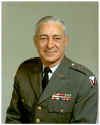1969
1969 During the third quarter, the stockpile reliability surveillance program was established to evaluate the reliability of Block III weapons after long periods of depot storage and field environmental conditioning.
1969 When the application of the "Should Cost" technique within DA was assigned to AMC, MICOM was selected to perform the first "Should Cost" study for the Army, with the Improved HAWK as the weapon system involved. The significance of the "Should Cost" method was to provide contracting officials with a base on which to start negotiations, rather than following the old practice of using the contractor's proposal and negotiating downward from that base.
1969 The Army began phasing out the SERGEANT Project Office.
1969 During the year, 30 NIKE HERCULES systems were deactivated from Army Air Defense Command (ARADCOM) sites.
7 January 69 The MARS II Product Office was organized.
1 February 69 The ADDCS Office was redesignated the ADCCS Product Office.
21 April 69 The ENTAC system was type classified as obsolete.
May 69 The first PERSHING 1a CONUS battalion received its equipment.
May 69 The first CHAPARRAL tactical battalion was activated.
9 May 69 An Army precedent was established at Redstone Arsenal when McKinley Range was dedicated by MMCS. Named for Specialist 6 Paul B. McKinley, who had formerly served at Redstone before his death in Vietnam in November 67, the dedication marked the first such commemoration for an EOD soldier. Most previous Army memorializations had honored infantrymen.

June 69 The Stovepipe system was extended to support the PERSHING in Europe. A partial Stovepipe system was also in effect for support of the HAWK and NIKE HERCULES in Europe.
25 June 69 By this date, over two-thirds of the units in the old Redstone Park housing area had been sold and moved to new locations in Alabama, Tennessee, Mississippi, and Georgia. The remainder of the 300 original housing units were removed by August.
1 July 69 The ADCAT Product Office (Provisional) was established, combining the product offices for ADCCS and Target Missiles.
22 July 69 AMC approved the release of PERSHING 1a equipment subject to certain conditions involving system safety.
23 July 69 MG Charles W. Eifler, MICOM Commander, was nominated for promotion to Lieutenant General and assigned as deputy to the Commander in Chief, USAREUR and 7th Army. He was only the second officer from Redstone Arsenal in 28 years selected to move up to a three-star post and the first to go to a major Army combat command.
20 August 69 The LITTLEJOHN weapon system was type classified obsolete by the AMC Technical Committee.
September 69 The conversion from PERSHING I to PERSHING 1a was completed for the 4th Batta-lion, 41st Artillery, the first U.S. European battalion. This started Project SWAP, a program for replacing PERSHING I equipment deployed in Europe with PERSHING 1a materiel.
1 September 69 The U.S. Army Medical Department Activity (MEDDAC), Redstone Arsenal, was organized and assigned to the Third U.S. Army. Its mission was to provide health services to authorized persons at Redstone and satellite activities.
October 69 AMC directed MICOM to implement a program to improve weapon systems acquisition known as the "Program for the Refinement of the Materiel Acquisition Process" (PROMAP-70).
15 October 69 Effective this date, the SERGEANT Project Office was abolished. Phaseout of the organization had started on 1 July 69. Concurrently, the SERGEANT Commodity Office was established to assume residual functions for the system.
17 November 69 BG Edwin I. Donley assumed command of MICOM. He had previously served as PERSHING PM (October 63-January 66) and as DCG, Land Combat Systems (until January 67). He was promoted to major general on 1 December 69.

31 December 69
The Chrysler Corporation Missile Division, prime contractor for the REDSTONE and JUPITER missile projects and other defense work, vacated the Michigan Army Missile Plant.
Excellence in Missilery:
Introduction,
1962,
1963,
1964,
1965,
1966,
1967,
1968,
1969,
1970,
1971,
1972,
1973,
1974,
1975,
1976,
1977,
1978,
1979
